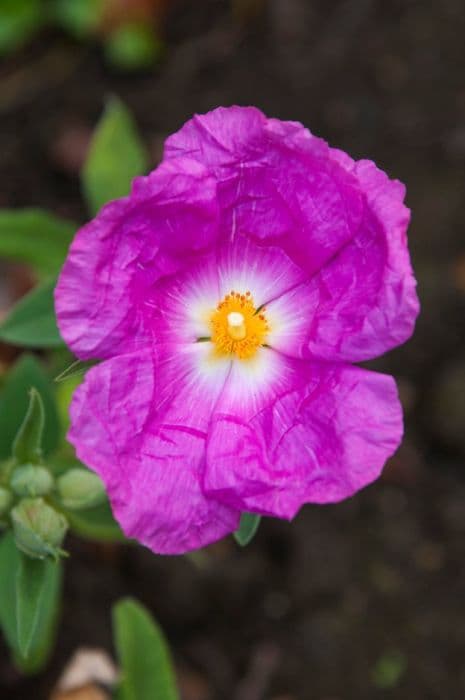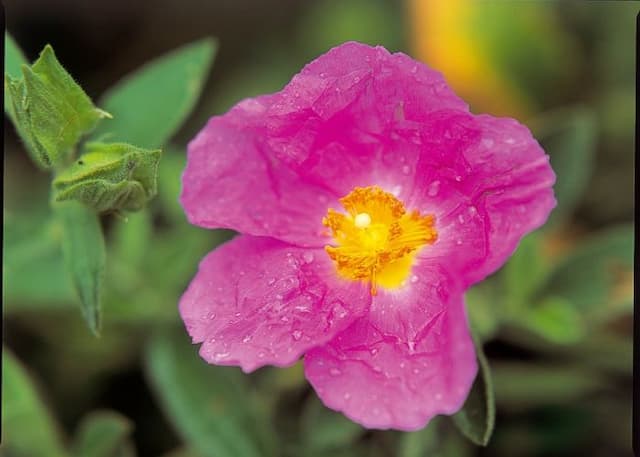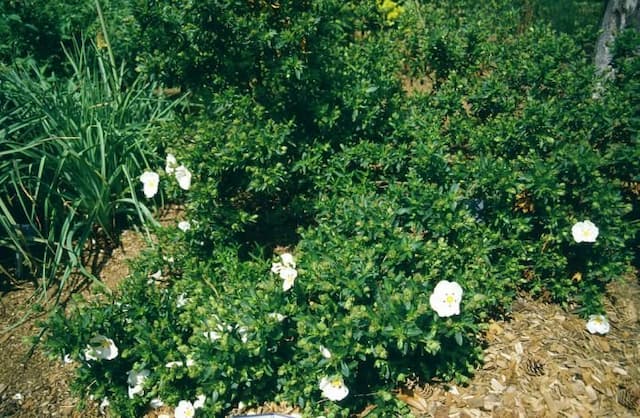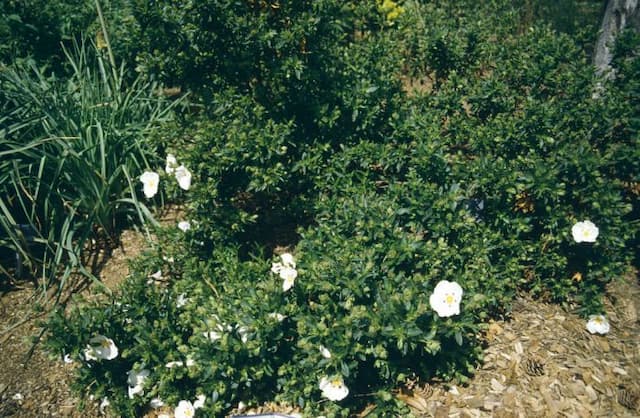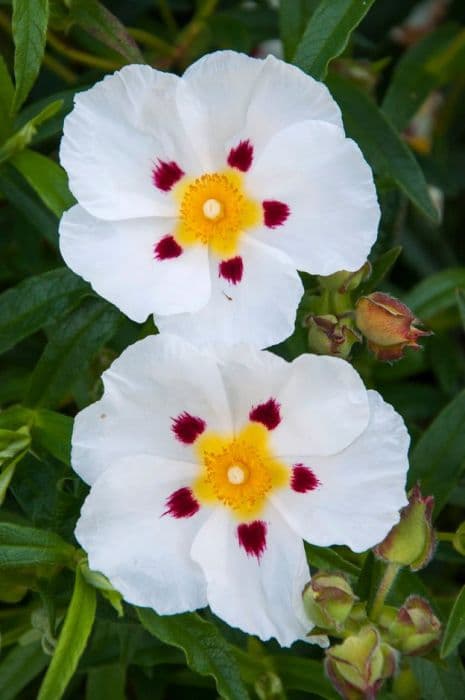Rock Rose Cistus × hybridus

ABOUT
Cistus × hybridus, commonly known as the Rock Rose, is a beautiful evergreen shrub that is admired for its ornamental appeal. This plant showcases a dense and bushy appearance with its foliage arranged in a slightly overlapping manner that gives it a lush texture. The leaves are dark green, slightly wrinkled, and have an oblong to lance-shaped form, often sporting a sticky texture that can catch on your fingers when touched. The most striking feature of the Rock Rose is its flowers. They bloom profusely and are composed of five petals that create a delicate, tissue-paper-like look. These petals can vary in color but are commonly found in shades of white or pale pink, often with a yellowish base or center, giving them a radiant appearance that contrasts elegantly against the dark foliage. Furthermore, each bloom possesses a multitude of stamens at its center, which tend to be a golden-yellow color, providing a lovely accent that complements the light nature of the petals. The flowers are short-lived, often opening with the sunlight of the morning and withering by the end of the day, yet the plant continuously produces new blooms to replace the old, maintaining its decorative aspect throughout the blooming season. Rock Rose has a resilience and adaptability that, alongside its visual charm, makes it a favorite among gardeners looking not only for aesthetics but also for a plant that can withstand a variety of conditions while still maintaining its allure. Its overall shape is rounded and mounding, presenting a harmonious and dense assembly of branches, leaves, and flowers that contribute to its visual impact in a landscape setting.
About this plant
 Names
NamesFamily
Cistaceae
Synonyms
Warley Rose, Elma's Rockrose, Hybrid Rockrose
Common names
Cistus × cyprius, Cistus monspeliensis, Halimium × hybridum, Cistus × corbariensis, Cistus × incanus.
 Toxicity
ToxicityTo humans
The Cistus × hybridus, commonly known as the Rockrose, is not known to be toxic to humans. There are no significant symptoms associated with poisoning because it is not considered a poisonous plant. Therefore, ingesting parts of the Rockrose typically does not lead to any harmful consequences for humans.
To pets
The Cistus × hybridus, or Rockrose, is also not known to be toxic to pets. It does not contain any known toxic substances that could lead to symptoms of poisoning in animals. As such, ingestion of the Rockrose by pets is not expected to result in any adverse health effects.
 Characteristics
CharacteristicsLife cycle
Perennials
Foliage type
Evergreen
Color of leaves
Green
Flower color
White
Height
3 feet (0.91 meters)
Spread
5 feet (1.52 meters)
Plant type
Shrub
Hardiness zones
8
Native area
Mediterranean
Benefits
 General Benefits
General Benefits- Drought Tolerance: Cistus × hybridus, commonly known as Rockrose, is highly drought-resistant and ideal for xeriscaping, reducing the need for irrigation.
- Low Maintenance: Rockrose is easy to care for with minimal pruning and feeding, making it a convenient choice for gardeners of all skill levels.
- Erosion Control: The plant's extensive root system helps to stabilize slopes and prevent soil erosion.
- Attracts Wildlife: Rockrose flowers attract pollinators such as bees and butterflies, supporting biodiversity.
- Landscape Aesthetics: The plant's profuse, showy flowers and evergreen foliage enhance the visual appeal of gardens and landscapes.
- Adaptability: Rockrose can thrive in poor soil conditions and harsh coastal environments, making it versatile for different landscaping needs.
- Fast Growth: The plant grows quickly, providing rapid coverage and fulfilling landscaping design elements without a long wait.
 Medical Properties
Medical Properties- Antioxidant activity: Cistus × hybridus has been shown to have antioxidant properties which could help protect cells from oxidative damage.
- Antimicrobial effects: The plant has been reported to have antimicrobial properties against certain bacteria and fungi.
- Anti-inflammatory properties: Cistus × hybridus extracts may have anti-inflammatory effects that could be beneficial in reducing inflammation.
- Astringent: Traditionally, it has been used for its astringent properties to help treat skin conditions and wounds.
 Air-purifying Qualities
Air-purifying QualitiesThis plant is not specifically known for air purifying qualities.
 Other Uses
Other Uses- Cistus × hybridus, also known as Rock Rose, can be used as a natural dye as it produces a range of colors depending on the mordant used.
- The plant is sometimes used in the making of perfumes for its warm, amber-like scent which is especially prevalent in its resin, labdanum.
- Rock Rose's sticky leaves can serve as a non-toxic adhesive trap for small insects and pests in the garden.
- The leaves of Rock Rose can be added to compost piles as they are rich in essential oils and can act as a natural compost accelerator.
- It can be used in landscaping to help prevent soil erosion due to its robust root system and hardiness.
- This plant acts as a protective companion plant in gardens, providing cover for beneficial insects and small wildlife.
- Rock Rose shrubs are often incorporated into fire-resistant planting schemes due to their ability to survive fires.
- The flowers can be used for decorative purposes in dried floral arrangements, retaining shape and color for extended periods.
- Rock Rose has been traditionally used to flavor certain traditional Mediterranean alcoholic beverages.
- The resin from Rock Rose, labdanum, is used in the food industry as a flavoring agent in certain baked goods and confectioneries.
Interesting Facts
 Feng Shui
Feng ShuiThe Rockrose is not used in Feng Shui practice.
 Zodiac Sign Compitability
Zodiac Sign CompitabilityThe Rockrose is not used in astrology practice.
 Plant Symbolism
Plant Symbolism- Resilience: Cistus × hybridus, more commonly known as the Rockrose, often grows in tough, rocky conditions, symbolizing the ability to endure and thrive in challenging environments.
- Beauty: With its beautiful flowers, Rockrose is a symbol of natural beauty and the enjoyment of life's aesthetic pleasures.
- Healing: Historically, Rockrose has been used in medicinal remedies, representing healing and regeneration.
- Protection: The thick, resinous substances produced by Rockrose were used in ancient times for skincare and embalming, symbolizing protection and preservation.
- Survival: The plant's hardiness and ability to survive fires through its seed regeneration, symbolizes rebirth and the power of survival against all odds.
 Water
WaterThe rockrose (Cistus × hybridus) prefers to be watered thoroughly but infrequently, needing time for the soil to dry out between watering sessions. Generally, it should be watered deeply once every 1 to 2 weeks, depending on weather conditions, with more frequent watering required during hot, dry periods. Use approximately 1 gallon of water per plant for each watering session, ensuring it's applied directly to the base and avoiding wetting the foliage. During winter months, reduce watering to minimize the risk of root rot, especially if the plant is established and is located in well-draining soil.
 Light
LightThe rockrose thrives best in full sun, requiring at least six hours of direct sunlight per day to perform optimally. Choose a spot in the garden that receives unfiltered sunlight for the majority of the day. Avoid placing the plant in shaded areas, as too much shade can lead to sparse growth and fewer flowers.
 Temperature
TemperatureRockrose is adapted to a Mediterranean climate and tolerates a temperature range from about 20 to 100 degrees Fahrenheit. The ideal temperature for the rockrose is between 60 and 80 degrees Fahrenheit, where it can grow vigorously. While it can withstand brief periods of colder temperatures, sustained freezes below 20 degrees Fahrenheit may cause damage to the plant.
 Pruning
PruningPruning rockrose is important to maintain its shape and encourage fresh growth. Prune immediately after flowering, typically in late spring or early summer, by removing dead flowers and shaping the plant to your preference. Avoid heavy pruning, as rockrose does not respond well to cutting into old wood. Annual light pruning is usually sufficient.
 Cleaning
CleaningAs needed
 Soil
SoilRockrose (Cistus × hybridus) thrives in well-draining soil with a slight preference for acidic to neutral pH, typically between 5.0 and 7.5. A good mix is one part peat, one part perlite, and two parts loam or a commercial potting mix designed for Mediterranean or dry-climate plants.
 Repotting
RepottingRockrose (Cistus × hybridus) should generally be repotted only when it has outgrown its current pot, which is usually every 2 to 3 years. Be cautious not to disturb the roots excessively during repotting.
 Humidity & Misting
Humidity & MistingRockrose (Cistus × hybridus) prefers a relatively low humidity environment, typical of its Mediterranean origin. Average indoor humidity levels are usually sufficient for this plant.
 Suitable locations
Suitable locationsIndoor
Place Rockrose in bright light with some direct sun indoors.
Outdoor
Plant Rockrose in full sun, well-drained soil, and shelter from wind.
Hardiness zone
8-11 USDA
 Life cycle
Life cycleCistus × hybridus, commonly known as White Rockrose, begins its life cycle with seed germination, which is often erratic and can benefit from scarification to improve germination rates. After sprouting, the seedling stage involves the development of the root system and initial leaves. As the plant grows, it enters a vegetative stage, where stem elongation and leaf expansion occur, and the plant establishes a robust, woody base. After reaching maturity, which may take several years, the White Rockrose produces showy white flowers with a distinctive yellow center, usually in late spring to early summer. Following the flowering period, the plant sets seeds which are then dispersed, often by wind or small animals. White Rockrose can also spread vegetatively through layering, where branches touching the ground develop roots and form new plants.
 Propogation
PropogationPropogation time
Spring to Summer
Propogation: Cistus × hybridus, commonly known as the Rockrose, is often propagated by semi-ripe cuttings taken during the late summer. This method involves selecting healthy, semi-ripe wood from the current year's growth, typically between July and September. A cutting about 4 to 6 inches (10 to 15 centimeters) long is trimmed just below a node, where a leaf joins the stem. The lower leaves are removed, and the base of the cutting is dipped in rooting hormone to encourage root development. The prepared cutting is then inserted into a pot filled with a well-draining potting mix, such as a blend of peat and perlite or sand. The cutting should be kept in a warm, bright place, out of direct sunlight, and maintained with high humidity, often by using a transparent cover to create a greenhouse effect. With proper care, the cutting will typically root within a few weeks, after which it can be gradually acclimated to less humid conditions and eventually planted out.
